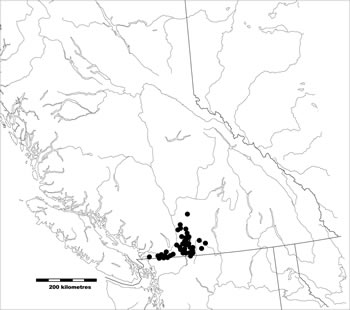The Mountain Beaver is not actually a beaver. It is a forest-dwelling rodent that could be mistaken for a muskrat or a juvenile marmot at first glance, but it is actually quite distinctive. It is a thick-bodied rodent that is generally dark (grey) above and tan to light grey below, with tiny ears and small eyes, short, furry tail, long claws for burrowing on the front and hind feet, and (often) a white spot below the ear (Nagorsen 2005). In British Columbia, Mountain Beaver often have white patches on the chest, stomach and flanks (Nagosen 2005).
Two subspecies are found in BC: A. r. rufa and A. r. rainieri. These subspecies overlap in morphology, but are readily distinguishable using DNA analysis (Ransome 2003).
Global Range
In North America, the Mountain Beaver is found from the South Coast region of British Columba, south to the Sierra Nevada mountain range of Southern California (Nagorsen 2005).
Distribution in British Columbia
According to Ransome (2003), the exact geographic extent of the Mountain Beaver and its two subspecies in BC is not well understood. Generally, however, the species is found in the Cascades (eastern slopes) and the Fraser Valley south of the Fraser River, and there are no confirmed records north or northwest of the Fraser River. Distribution of the two subspecies is described by Ransome: “A. r. rufa is found south of the Fraser River and its range may extend from Hope to Langley in the Lower Mainland of B.C. A. r. rainieri is found east of the Fraser River and Hope, and extends west to Princeton and along the Cascade Mountains from the Canada-US border north to Merritt and Lytton.” Because of difficulty in separating the two subspecies, the exact boundary separating the two subspecies in the province is unknown, however it is generally in an area between Chilliwack and Manning Park (Ransome 2003). Note that although there are confirmed records of Mountain Beaver in the Langley area, these may not represent persistent populations--the westernmost persistent populations are Sumas/Chilliwack Mountains and Vedder Mountains.
Notes:
Mountain Beaver are the world's most primitive rodent and have a primitive kidney that prevents them from being able to conserve water by concentrating urine (Nagorsen 2005, Ransome 2003). Because of this, they need to have large quantities of succulent vegetation and/or water available in order to survive (Ransome 2003).
This is a solitary, burrowing species with a small home range. Nagorsen (2005) describes the burrows as containing a nest chamber, tunnels for refuse and waste, toilet chambers, and several (sometimes plugged) tunnels that open to the surface.
